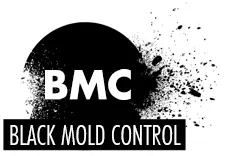Are you concerned that you have black mold in your home? Black mold is a common microfungus that occurs when building material has become waterlogged. Toxic to humans, exposure to black mold can cause respiratory problems, fatigue, allergic reaction, and chronic headaches. While such a problem can be frustrating and stressful, expert assistance can make black mold remediation and removal easy, and quickly kill the noxious fungus anywhere that it lives. Here’s some more information about professional removal.
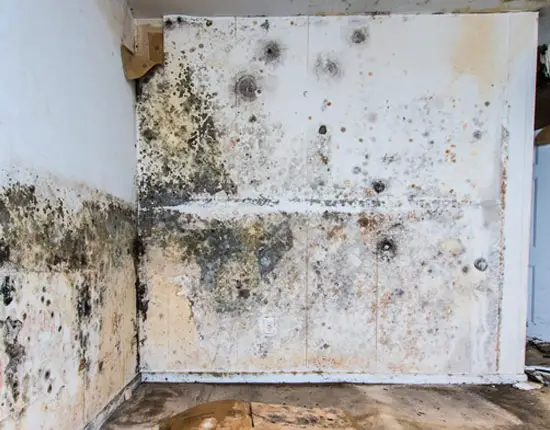
What is black mold?
Black mold is a type of fungus as well as a relatively common household problem. In nature, fungus breaks down dead organic materials and is beneficial to the ecosystem. Unfortunately, black mold can cause health problems when found in an enclosed space, such as a home or business. Mould can cause allergic reactions as well as other health problems. People who have a compromised respiratory or immune system are usually affected more severely. For some, mold exposure can be dangerous. It can also damage materials and leave unpleasant stains. Want to know more information on the health effects, risks and symptoms? Read our article: black mold symptoms.
How to identify black mold?
The first thing one must do is identify the presence of fungus. As the name implies, black mold is usually a dark color that can be easily spotted. This does not always mean that it can be found easily. Hidden patches may grow in hard-to-reach areas, behind unaffected surfaces or simply in places one may not often look. When mould is not immediately seen, it is typically identified by smell or the presence of excessive moisture. Mildew has a musty odor and only grows in damp or wet areas. If a material has been wet for more than two days, one can usually assume there is mold growth. Recommended article: How to identify mold
How to remove black mold naturally?
While professional removal is necessary in cases of extensive growth, it’s possible to kill smaller surface infestations with natural ingredients that you can purchase at the store, or may even already have in your home.
One method is to spray the affected area with undiluted vinegar, let it sit for several hours, then scrub to remove. A similar cleaning technique can be used with a diluted solution of tea tree oil in water, or, for a less pungent treatment, a diluted mixture of citrus seed oil.
Another option is a 3% solution of hydrogen peroxide sprayed directly onto the area, but be careful and patch test it in a less visible spot first, as peroxide can damage or discolor certain materials.
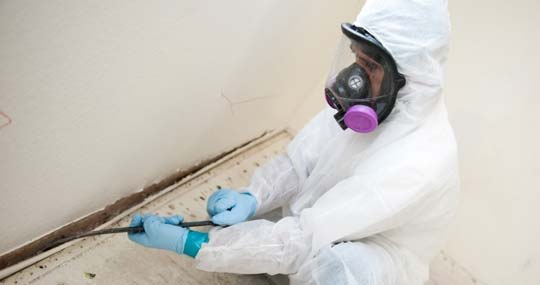
Precautions and protective gear
Before beginning mold remediation, it is important to have appropriate protective gear. Mould can cause irritation or health problems if it is inhaled or exposed to the skin or eyes. This means that steps must be taken to protect against exposure. Anyone who has respiratory issues, such as asthma or emphysema, or a compromised immune system, like that of HIV or lupus patients, shouldn’t be exposed to black mold. Anyone who is especially susceptible to mould should vacate the area until the mold cleanup is complete. Proper ventilation is another necessary consideration to preserve the health of all involved in the removal of black mould.
Respirator mask
One vital piece of protective equipment for mold removal is a respirator mask. An N-95 mask should be worn at all times when dealing with mould. This will prevent the inhalation of harmful spores, particles, and chemicals. It is important to be aware that an N-95 mask is the minimum protection that should be used for black mold removal. A stronger mask can be used for extensive damage as well as if strong disinfectants or biocides will be used. Recommended respirator masks on Amazon.com
Gloves
Gloves are vital for protecting the skin during a black mold cleanup. Household rubber gloves that reach up to the elbows are sufficient in most cases. If using strong chemicals, high-quality gloves made of a material like natural rubber, PVC, nitrile, polyurethane or neoprene are recommended. If there is a chance that fungus or it’s spores will become attached to a person’s shoes or pants, such as during flooding, rubber boots should be worn. Recommended gloves on Amazon.com
Coverall
You definitely need a coverall with good elastic cuffs so the fungus can’t touch you. Equipped with eye protection, gloves and a mold respirator mask and you are good to go. Recommended coverall on Amazon.com
Eye Protection
Eye protection can help prevent irritation and infection. A pair of appropriately-sized, non-ventilated goggles ought to be worn at all times when dealing with black mold. Loose or porous goggles are not adequate protection. Recommended goggles on Amazon.com
Other Precautionary Measures
It is important to keep the fungus from spreading to other areas of the building. Small, isolated patches can usually be easily contained with proper handling. If the affected area is larger than ten square feet, plastic sheeting and tape should be used to separate the area from the rest of the building. Any vents near the site of the growth should be sealed. All HVAC systems and fans should be shut off to prevent spreading the spores. If the HVAC system has growth within it, the system shouldn’t be used and one should seek professional assistance. When the mold has spread to affect over one hundred square feet, it must be very carefully contained and usually requires professionals.
How to find the source of mold in your home?
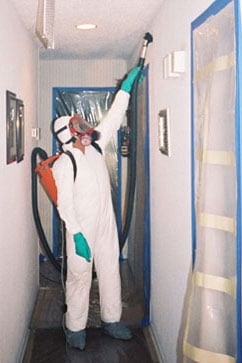 People encounter stray mildew spores on a daily basis. There is not a problem until a spore finds a wet area and begins to grow and spread more spores. The first step of mould removal is solving the cause of the problem, which is excessive moisture or wet materials. Without eliminating the moisture, new growth will simply appear after mould has been removed.
People encounter stray mildew spores on a daily basis. There is not a problem until a spore finds a wet area and begins to grow and spread more spores. The first step of mould removal is solving the cause of the problem, which is excessive moisture or wet materials. Without eliminating the moisture, new growth will simply appear after mould has been removed.
Any leaks should be repaired immediately. If something is spilled or a material becomes wet, it is important to dry it quickly to prevent the spores from growing. Even if there are no specific leaks or spills, household moisture can still cause mould to grow. Black mold thrives is a warm, wet environment. Once a home or business owner realizes that a building is excessively humid and producing fungus, he should install a dehumidifier and attempt to improve the building’s ventilation. Proper airflow reduces moisture and can prevent or stop mold growth.
Once the source of the moisture has been eliminated, one needs to make sure the area is dry. A wet vacuum can be used in areas where water has accumulated but is likely to spread spores if used on dry materials. If using a cloth or towel to dry an area, the material should be washed and dried soon after use.
Removing Black Mold
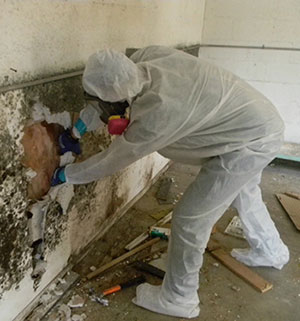 Simply killing or halting the growth of black mold is not sufficient to create a healthy environment. Even dead mildew can cause allergic reactions and other health problems. This makes it necessary to remove all traces of mould from the home. One of the most important parts of mold remediation (PDF) is to properly remove black mold from affected materials.
Simply killing or halting the growth of black mold is not sufficient to create a healthy environment. Even dead mildew can cause allergic reactions and other health problems. This makes it necessary to remove all traces of mould from the home. One of the most important parts of mold remediation (PDF) is to properly remove black mold from affected materials.
Non-Porous Materials
Non-porous materials can usually be salvaged. Surfaces should be scrubbed with a water and detergent mixture. A scrub brush with stiff bristles is often useful for removing all of the black mold from a surface. Unfortunately mildew often stains surfaces, and these stains can be difficult or even impossible to fully remove. Paint cannot simply be applied over an affected spot until the area has been properly treated, because the paint will usually just come off.
Cloth Items
Cloth items like clothing, sheets, curtains and other such items can usually be cleaned. All loose mould on the surface of the material should be carefully brushed off outside. Most of these materials can be machine-washed or dry-cleaned based on the manufacturer’s directions. They should then be thoroughly dried before hanging back in bedroom closet. Stains are common, and it is usually recommended that severely damaged items simply be discarded. Even carpeting can typically be cleaned as long as it is properly dried and cleaned with either dry soap or a water-detergent mixture.
Wood
The removal of black mold from wood can depend on the specific situation. In some cases the wood can be brushed off and scrubbed almost like a solid surface. In other instances it may become necessary to sand the area to remove the growth. See our in-depth removal guide: black mold on wood.
Porous Materials
Unfortunately, it is nearly impossible to remove black mould from most porous materials. Even tiny pores can be filled with this type of fungus, which cannot be simply scrubbed away on this kind of surface. Items such as books, paper, ceiling tiles and wall board must usually be discarded. The best chance one has to save porous materials is to quickly dry them before mold becomes an issue.
How to clean black mold?
Strong chemicals and disinfectants are not usually recommended. Proper drying, water and detergent will be sufficient in most situations. Disinfectants and biocides can be dangerous to the health of people and animals. These chemicals are usually only necessary if contamination is suspected. A disinfectant, such as bleach, is needed in cases where there may have been a health or sanitation problem with the water other than mold growth, such as sewer water or flood water. It is important to never mix cleaning solutions and chemicals, as this may produce toxic fumes. Always follow the manufacturer’s directions when using any type of equipment or chemical. When using any kind of chemical it is vital to properly ventilate the area, and wear protective items like those mentioned above.
How to get rid of black mold?
Once an area has been thoroughly cleaned, it can be rinsed to remove any leftover detergent or disinfectant. The area should then, of course, be completely dried and appropriately ventilated. This is also a good opportunity to check that nothing has been overlooked.
A high-efficiency particulate, or HEPA, vacuum should be used for the final black mold cleanup. This can be used to clean up dust, dirt and anything else that may hold stray spores or black mold particles. Unlike a standard vacuum, a HEPA vacuum has a filtration system that helps prevent harmful materials from being spread during cleaning.
Finally, all affected materials should be handled with care. All ruined items that are being discarded should be carefully sealed in a plastic bag before being removed from the area. If possible, mobile items should be cleaned and brushed off outdoors.
Black mold removal can be a difficult process, and it is a good idea to check the cleaned area in the future to be sure that no new growth has occurred. Prevention is the easiest way to deal with mold. Proper housekeeping, decisive action regarding leaks and spills and the use of a dehumidifier can save a person a lot of time, effort and money. [Good Read (PDF) – University of Georgia on Cleaning Mold]
How to remove from toilet
Cleaning black mold from a toilet is a relatively simple procedure. Porcelain, the substance that the majority of toilets are made from, is a tough, non-porous material. As a result, the fungus has a very hard time establishing a deep infestation, and treatment options can be harsher than you’d use for other locations.
A 1:10 bleach to water ratio can be sprayed onto the toilet, then wiped down. More resilient spots can be scrubbed with a brush or other tool, then a cup of bleach poured into the tank, and the toilet flushed to finish the cleaning process. Read our in-depth removal guide:black mold in toilet
How to remove from walls
Walls can be extremely hard to remove mold from, owing to the porous material that they’re constructed from and the difficulty of even accessing an infestation that has spread into the interior walls.
Superficial infestation sites can be dealt with personally with some difficulty and care, but a severe and established mold colony on or especially inside a wall is usually a good indication that you require the assistance of a remediation specialist.
For small, exterior patches on walls with a coating of non-porous paint, the same 1:10 ratio of bleach to water can be used, along with a stiff brush.
An infestation involving drywall generally requires total removal of the affected drywall, along with measures to ensure that mold spores aren’t further dispersed during removal. Read our in-depth removal guide:black mold on walls or more specific: black mold on drywall
How to remove from shower
Warm and damp, a shower is the perfect environment for an infestation to become established.
Limited, isolated surface infestations can again be killed using the 1:10 bleach solution and thorough cleaning, but fungus found along grout and shower tile borders may be a sign of deeper infiltration, necessitating removal of the tiles and possibly the underlying structure of the wall to assess and adequately treat the problem. Care should be taken not to spread the infestation to other parts of your bathroom. Read our in-depth removal guide: black mold in shower
How to remove from bathroom
To treat an infestation in your bathroom, the location of the infestation is the primary concern. Surface mold on non-porous surfaces, as in the shower and toilet, are more easily treated than deeply contaminated wood or drywall. If removal of material is required when treating your bathroom, care should again be taken to prevent the further spread of spores. Read our in-depth removal guide: black mold in bathroom
How to Remove from air vents
An infestation reaching deep into your air vents and ducts is among the very hardest situations to treat. Mild cases that are isolated to within a few inches of the exterior air vents can be treated similarly to other sites, using your choice of anti-fungal solution to kill the infestation, but severe cases may extend past the point that a layman can easily access. In these cases, the expertise of a professional remediation specialist is likely required. Read our in-depth removal guide: black mold in air vents
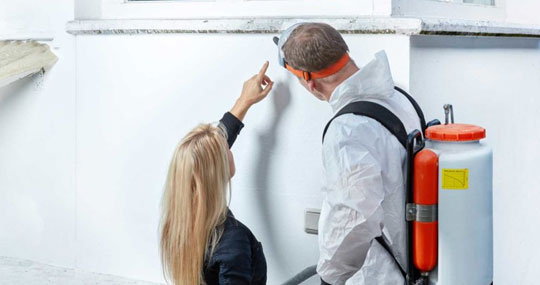
Black mold removal cost
The cost of professional removal varies widely depending on the location and severity of the problem. Thorough treatment of a minor infestation in an accessible area can run as low as $500, while a larger, more established problem can stretch well into the thousands, as remediation specialists may need to remove affected drywall, enter your walls in order to fully treat the problem, etc. While this may seem expensive, black mold can be intractable and if an infestation isn’t completely wiped out it can quickly come back with a vengeance, necessitating further treatment and driving the cost up even higher.
Infestations in air vents and other out of the way locations are necessarily more expensive, requiring special expertise and equipment to kill established colonies in cramped quarters. Extremely severe infestations that have spread extensively through walls, air vents, etc. can run into the tens of thousands of dollars.
Each infestation is different, and an inspection by a remediation specialist is necessary to evaluate the extent of your problem and provide you with an accurate estimate of your removal cost.
